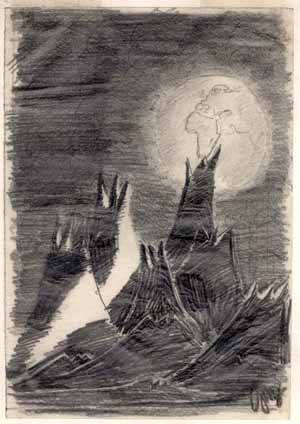The first Israeli astronaut, Col. Ilan Ramon, will take with him on his upcoming journey in space a painting drawn by a boy during the Holocaust, from the collection of the Yad Vashem Art Museum.

"moon view"
The first Israeli astronaut, Col. Ilan Ramon, will take with him on his upcoming journey in space a painting drawn by a boy during the Holocaust, from the collection of the Yad Vashem Art Museum.
Ramon stated that in light of the importance and meaning he sees in the Holocaust for him as a Jew and as an Israeli, and especially in light of his being the son of a mother who survived Auschwitz, some of whose family members perished in the Holocaust, he turned to Vashem and asked to take with him something related to the Holocaust.
Yad Vashem chose for him a painting painted by a Jewish boy named Peter Ginz when he was about 14 years old, imprisoned in the Theresienstadt ghetto when in his imagination he sails to far away places and paints the painting "Moonscape".
Peter Ginz was a multi-talented boy who from a young age drew, wrote articles, stories and poems. He continued to do so even during the time he was in the ghetto to which he was sent in 1942. In 1944, Peter was murdered in Auschwitz.
The lunar landscape emerging from Peter's painting testifies not only to his ambition to reach a place where the safety of the earth can be seen from a distance that threatens his life, but mainly to a boy who, in addition to all his other skills, is also a researcher and scientist. A young Elam is full of the optimistic belief that science comes first, and he is the one who will bring the balm to humanity.
In his conversation with Yad Vashem spokeswoman, Iris Rosenberg, from the space center in Houston, Texas - where he is training, astronaut Ilan Ramon said: "I feel that my journey is fulfilling Peter's dream 58 years away. The fact that he perished in the furnaces of Auschwitz is evidence of the physical limitation of his existence. His works, preserved in Yad Vashem, are evidence of the victory of the spirit. The victory of a boy blessed with talents who managed to soar beyond the reality of the ghetto in which he was imprisoned, through his imagination and talent."
Ramon will be launched into space on the "Columbia" shuttle. The painting he will take with him connects the dream of one Jewish boy, which is nothing but a symbol of the talent we lost in the Holocaust, to the journey of one Jewish and Israeli astronaut who is nothing but a symbol of our uprising.
Peter Guinness
And this is Haaretz newspaper's version of the same news
A drawing of a child murdered in the Holocaust will be sent into space
עודכן ב-10/06/02 19:28
The first Israeli astronaut, Col. Ilan Ramon - son of a Holocaust survivor, asked Yad Vashem to take something related to the Holocaust into space
By Yair Shelag
Major General Ilan Ramon, the first Israeli astronaut, will take with him on his space journey in about a month, a painting of a Jewish boy who was murdered in the Holocaust.
This is the painting "Moonscape", painted by Peter Ginz from Prague in 1942 when he was 14 years old in the Treizinstadt ghetto. In 1944 Ginez was murdered in the Auschwitz extermination camp.
Ramon is scheduled to go into space on the "Columbia" shuttle on July 19. Ramon recently contacted the Yad Vashem Institution and explained that in light of the importance he attaches to the Holocaust as a Jew and as an Israeli, and especially due to being the son of a mother who survived Auschwitz, he wishes to take something related to the Holocaust into space. The people of "Yad Vashem" chose the painting, from the art collection in their possession.
Ginz, the young painter, is considered a talented boy who from a young age was engaged not only in painting but also in writing articles, stories and poems. The people of "Yad Vashem" estimate that he actually painted the moon, because it symbolized for him a place of safety, far from the earth where he lived under threat.
In a conversation with "Yad Vashem" people, Ramon said: "I feel that my journey is fulfilling Petar's dream 58 years away. The fact that he perished in the furnaces of Auschwitz is evidence of the physical severity of his existence. His works are evidence of the victory of the spirit; The victory of a boy blessed with talents who managed to soar beyond the reality of the ghetto he was imprisoned in, through his imagination and talent."

One response
Thanks for the article.